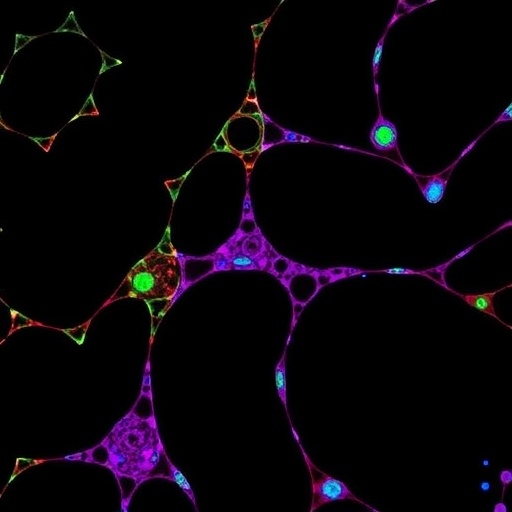In a groundbreaking advance in cancer therapy, researchers have unveiled innovative findings identifying Cucurbitacin S and Kammogenin as potent inhibitors of focal adhesion kinase 2 (FAK2), a molecule that plays a crucial role in cancer cell proliferation and metastasis. This discovery paves the way for targeted treatment options that can specifically hinder the progression of various cancers. The research highlights the enormous potential of computational methods in drug discovery, offering a glimpse into a future where disease management becomes more personalized and effective.
Focal adhesion kinase 2 is a critical regulator of cell signaling pathways that support tumor growth and recurrence. Under normal circumstances, FAK2 helps cells adhere to their environment and communicate with one another. However, in cancer cells, FAK2 often promotes aggressive behavior, allowing tumors to spread and invade surrounding tissues. Targeting this kinase presents a compelling strategy for stemming the tide of cancer metastasis.
Utilizing advanced computational algorithms, the research team embarked on a systematic analysis of natural compounds that could serve as efficient FAK2 inhibitors. By leveraging biological databases and powerful predictive modeling, they identified Cucurbitacin S and Kammogenin, two naturally derived compounds, as key players in silencing the aggressive activities of FAK2. The meticulous computational screening process is a potent reminder of how technology can transform traditional drug discovery into a more efficient and targeted endeavor.
Following the identification of these two compounds, the researchers conducted rigorous in vitro studies to verify their efficacy as FAK2 inhibitors. Preliminary results showed that both Cucurbitacin S and Kammogenin significantly reduce FAK2 activity in cancer cell lines, leading to decreased cell proliferation and migration. This promising outcome reinforces the hypothesis that inhibiting FAK2 could halt the invasive capabilities of cancer, opening the door to new therapeutic modalities.
One of the compelling aspects of this research is the focus on natural compounds. Both Cucurbitacin S and Kammogenin are derived from plants, underscoring the value of ethnopharmacology in modern medicine. The use of natural products not only enhances the safety profile of potential therapeutics but also allows researchers to tap into centuries of traditional knowledge about the healing properties of these botanical substances. This emphasizes a fundamental shift toward exploring nature’s pharmacy for solutions to contemporary health crises.
The implications of these findings stretch beyond FAK2. While targeted therapies have revolutionized cancer treatment, they often come with substantial costs and side effects. Introducing natural compounds like Cucurbitacin S and Kammogenin could lead to more affordable and safer options for patients seeking effective cancer treatments. Furthermore, the study opens the door to further exploration of other natural compounds that may exhibit similar inhibitory effects on various cancer-related pathways.
As the research team continues their studies, they intend to delve deeper into the mechanistic pathways influenced by Cucurbitacin S and Kammogenin. Understanding how these compounds interact at the molecular level will not only elucidate their role as FAK2 inhibitors but could also unveil additional targets for cancer therapies. This phase of research is crucial to ensure that any future drug candidates can not only inhibit FAK2 effectively but also minimize potential off-target effects that can complicate treatment regimens.
The recognition of Cucurbitacin S and Kammogenin as FAK2 inhibitors emphasizes a broader trend in biomedical research: the increasing reliance on computer-aided drug design. The integration of artificial intelligence and machine learning into this field allows researchers to sift through vast libraries of compounds, rapidly identifying those with therapeutic potential. This method significantly reduces the time and cost associated with traditional drug discovery, enabling faster translation of findings from bench to bedside.
In conclusion, the identification of Cucurbitacin S and Kammogenin as inhibitors of FAK2 stands as a testament to the power of innovation in the fight against cancer. With further exploration and validation, these compounds could soon form the basis of new, targeted therapeutic strategies aimed at enhancing survival rates and quality of life for cancer patients. This research not only exemplifies the synergy between computational biology and pharmacology but also reinforces the need for continued exploration of natural products in clinical applications. The journey from compound identification to clinical efficacy is complex and requires thorough investigation, yet the potential rewards are immense in terms of advancing cancer care.
As we progress into an era of precision medicine, the findings of this study remind us of the importance of interdisciplinary collaboration and the relentless pursuit of knowledge. Continuing down this path of discovery may ultimately lead us to novel solutions that could dramatically alter the landscape of cancer therapy. It is precisely through such innovative approaches that we can hope to transform oncology from a reactive to a proactive field, equipped with tools capable of tackling one of humanity’s most challenging diseases.
The implications of this research resonate well beyond the laboratory. They serve as a clarion call for the scientific community to embrace modern methodologies while respecting ancient traditions of medicinal discovery. The potential for creating effective cancer therapies rooted in natural products is vast, and the journey has only just begun. As we continue to explore the intersections of technology and nature, we stand on the brink of a new frontier in cancer treatment.
Subject of Research: Identification of Cucurbitacin S and Kammogenin as FAK2 inhibitors for cancer therapy.
Article Title: Computational identification of Cucurbitacin S and Kammogenin as bioactive focal adhesion kinase 2 inhibitors for targeted cancer therapy.
Article References:
Alharethi, S.H., Mohamed, F.A.M., Alakilli, S.Y.M. et al. Computational identification of Cucurbitacin S and Kammogenin as bioactive focal adhesion kinase 2 inhibitors for targeted cancer therapy.Mol Divers (2025). https://doi.org/10.1007/s11030-025-11413-1
Image Credits: AI Generated
DOI: https://doi.org/10.1007/s11030-025-11413-1
Keywords: FAK2, Cucurbitacin S, Kammogenin, cancer therapy, targeted treatment, natural compounds, computational drug design, precision medicine.
Tags: advanced predictive modeling in researchbioactive compounds in cancer therapycancer cell proliferation inhibitorscomputational drug discovery methodsCucurbitacin S cancer treatmentfocal adhesion kinase 2 inhibitorsinnovative findings in cancer researchKammogenin and cancer metastasisnatural compounds for cancer treatmentpersonalized medicine in oncologytargeted cancer therapiestumor growth regulation strategies






